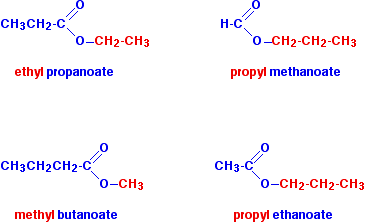|
ESTERIFICATION OF CARBOXYLIC ACIDS This page looks at esterification - the reaction between alcohols and carboxylic acids to make esters. What are esters? Esters have a hydrocarbon group of some sort replacing the hydrogen in the -COOH group of a carboxylic acid. We shall just be looking at cases where it is replaced by an alkyl group, but it could equally well be an aryl group (one based on a benzene ring). A common ester - ethyl ethanoate The most commonly discussed ester is ethyl ethanoate. In this case, the hydrogen in the -COOH group has been replaced by an ethyl group. The formula for ethyl ethanoate is:
Notice that the ester is named the opposite way around from the way the formula is written. The "ethanoate" bit comes from ethanoic acid. The "ethyl" bit comes from the ethyl group on the end. | ||
|
Note: In my experience, students starting organic chemistry get more confused about writing names and formulae for esters than for almost anything else - particularly when it comes to less frequently met esters like the ones coming up next. Take time and care to make sure you understand! | ||
|
A few more esters In each case, be sure that you can see how the names and formulae relate to each other.
Remember that the acid is named by counting up the total number of carbon atoms in the chain - including the one in the -COOH group. So, for example, CH3CH2COOH is propanoic acid, and CH3CH2COO is the propanoate group. | ||
|
Note: You can find more about naming acids and esters by following this link to a different part of this site. Use the BACK button on your browser to return to this page. | ||
|
Making esters The chemistry of the reaction Esters are produced when carboxylic acids are heated with alcohols in the presence of an acid catalyst. The catalyst is usually concentrated sulphuric acid. Dry hydrogen chloride gas is used in some cases, but these tend to involve aromatic esters (ones containing a benzene ring). If you are a UK A level student you won't have to worry about these.The esterification reaction is both slow and reversible. The equation for the reaction between an acid RCOOH and an alcohol R'OH (where R and R' can be the same or different) is:
So, for example, if you were making ethyl ethanoate from ethanoic acid and ethanol, the equation would be:
| ||
|
Note: The mechanism for the esterification reaction is covered in the catalysis section of this site. It is not required for any UK A level chemistry syllabus. If you follow this link, use the BACK button on your browser to return to this page. | ||
|
Doing the reactions On a test tube scale Carboxylic acids and alcohols are often warmed together in the presence of a few drops of concentrated sulphuric acid in order to observe the smell of the esters formed. You would normally use small quantities of everything heated in a test tube stood in a hot water bath for a couple of minutes. Because the reactions are slow and reversible, you don't get a lot of ester produced in this time. The smell is often masked or distorted by the smell of the carboxylic acid. A simple way of detecting the smell of the ester is to pour the mixture into some water in a small beaker. Esters are virtually insoluble in water and tend to form a thin layer on the surface. Excess acid and alcohol both dissolve and are tucked safely away under the ester layer. Small esters like ethyl ethanoate smell like typical organic solvents (ethyl ethanoate is a common solvent in, for example, glues). As the esters get bigger, the smells tend towards artificial fruit flavouring - "pear drops", for example. On a larger scale If you want to make a reasonably large sample of an ester, the method used depends to some extent on the size of the ester. Small esters are formed faster than bigger ones. To make a small ester like ethyl ethanoate, you can gently heat a mixture of ethanoic acid and ethanol in the presence of concentrated sulphuric acid, and distil off the ester as soon as it is formed. This prevents the reverse reaction happening. It works well because the ester has the lowest boiling point of anything present. The ester is the only thing in the mixture which doesn't form hydrogen bonds, and so it has the weakest intermolecular forces. | ||
|
Note: Follow this link if you aren't sure about hydrogen bonding. Use the BACK button on your browser to return to this page. | ||
|
Larger esters tend to form more slowly. In these cases, it may be necessary to heat the reaction mixture under reflux for some time to produce an equilibrium mixture. The ester can be separated from the carboxylic acid, alcohol, water and sulphuric acid in the mixture by fractional distillation. | ||
|
Note: Providing full details for organic preparations (including all the steps necessary in cleaning up the product) is beyond the scope of this site. If you need this sort of detail, you should be looking at an organic practical book. | ||
© Jim Clark 2004 (modified November 2015) |
||



